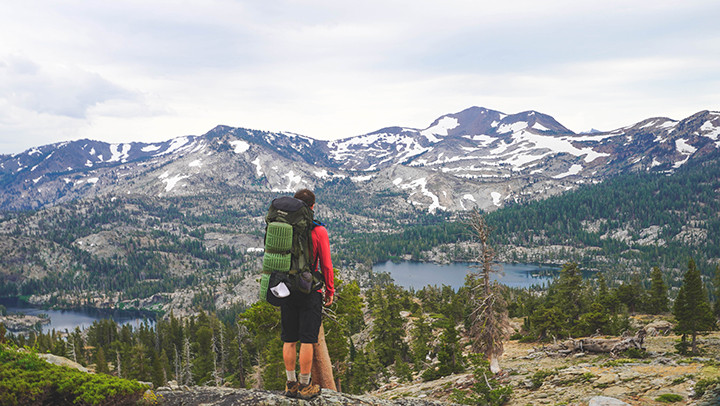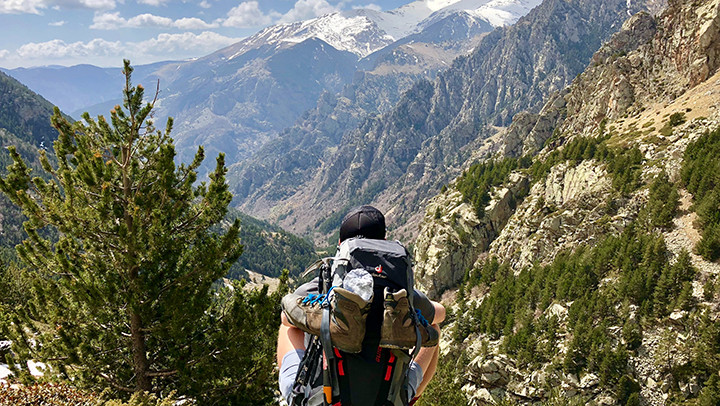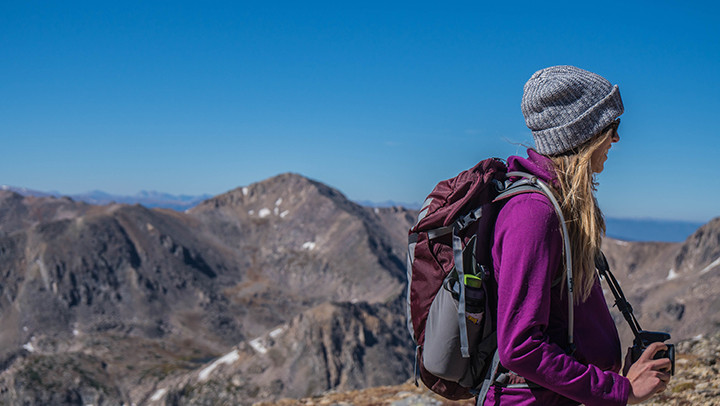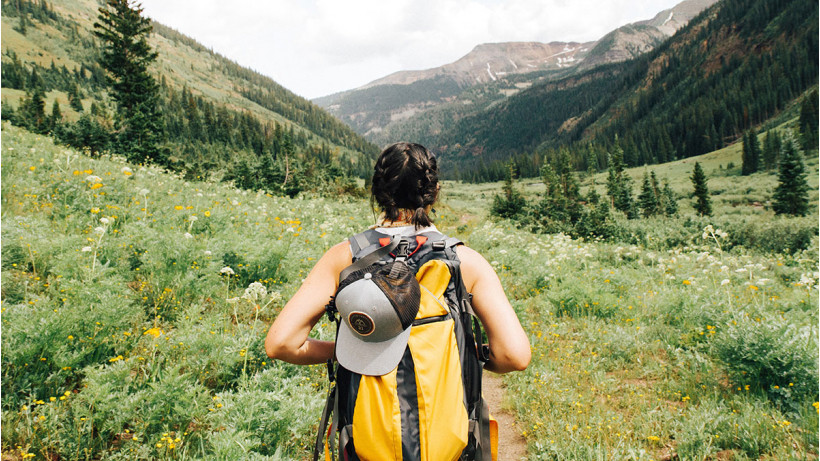One year and 3,000 miles of hiking: Some of the toughest trekking challenges in the world
Thru-hiking is a term used with varied rules. For some it means a significantly prolonged period of hiking without extended stops, for others, including the Appalachian Trail Conservancy, it amounts to completing an established end to end long-distance trail with continuous footsteps within one calendar year – so not your average weekend trip in the countryside. In the US, the most famous routes are the Appalachian Trail (AT), the Pacific Crest Trail (PCT), and the Continental Divide Trail (CDT), although there are many more around the world.
As challenges go, thru-hiking is up there with some of the toughest. Most in the US will take well over four months to complete, with the planning required to undertake the journey needing at least the same amount of time before even setting foot out of the door. The Continental Divide Trail, the longest of the three main routes (known collectively as the Triple Crown), covers 3,100 miles of hiking, taking people all the way from Mexico to Canada.
- Travel epic: Trekking holidays for serious outdoors types
Although the numbers aren’t entirely clear, those who complete a thru-hike every year across the US are understandably low, with just a few thousand people managing to complete one of the three main trails. To put that into context, 800 people climbed Everest in 2018 – so you can start to see the level of dedication needed to be a successful thru-hiker.
But what’s the pull behind thru-hiking? How difficult is it really and what do you need to know about it before even contemplating taking on one of the challenges? Here we cover the basics of what to expect, where to go and the kind of things you need to think about.
The history of thru-hiking

The history of long-distance walking is not so much based on enjoyable pastimes as it is with necessity; a time when hiking was an unavoidable choice as opposed to a recreational hobby. However, in the case of most modern hiking trails, there was a conscious and planned decision to create something that would not only act as a protected place for people to enjoy, but also help minimise the movements and damage caused by hikers.
In the case of the main three thru-hiking routes in the US, planning for the trails began in the 1920s, with the founders of each beginning their quests to combine whatever smaller routes existed at the time in order to build one accessible highway for walkers and horse riders. Each story is long and detailed (and you can read about them via each association’s website), but with the continued development and growth of the projects, the three separate trail associations were formed; monitoring, managing and in most cases, still developing large parts of each trail.
As the trails have grown, so have the number of people taking on the routes. The Pacific Trail alone saw just a handful of people a year registered as completing the full distance in the 1950s and 1960s but this rose to over 1,100 in 2018. As technology gets better, so do the chances of success for people wanting to take on the hikes – as does social media’s ability to showcase what they have to offer.
Why thru-hike?

Let’s start with the obvious question. For some, a six-month trek devoid of any luxuries, comforts and with limited downtime would sound like mindless rantings. To others, it’s the sort of character-defining challenge that makes life worth living. However, unlike a marathon or a hike up a mountain, thru-hiking is a decision that will not only take months out of your year but also comes with a host of dangers that mean you need to take a fair amount of precautions.
But why do people decide to do it? We asked the very same question to people that have already completed a thru-hike to find out what drove them to take on the challenge. As you’d expect, there’s no obvious answer, with people deciding to head out with dozens if not thousands of different personal reason for crossing the wilderness with nothing but a backpack and a positive attitude.
Nalini, now a seasoned hiker and blogger, took on the Appalachian Trail in 2010 without having done any backpacking before, after the company she worked for went into financial meltdown. “I saw a documentary on people thru-hiking the Appalachian Trail and thought it was a way to challenge myself I’d never had before,” she told us. “I also always had this desire to explore the outdoors but didn’t know the right way to do it and I figured this was an opportunity to finally learn about it. There are so many high points – friends visiting, trail magic, beautiful sunrises and sunsets and the kindness of strangers.”
Other people who do it are more experienced. Ryan, who covered the Appalachian Trail in 2014, told us “I’d wanted to hike the AT since my first backpacking trip when I was eleven. My great-uncle did it, my mom wanted to, and my brother still wants to.” Commenting on the whole experience Ryan added, “Nobody hikes the Appalachian Trail alone. There’s a strong sense of community, even when you talk to someone going the other direction, whom you’ll never see again. Everyone looks out for everyone.”
How fit do you need to be?
Hiking for a few hours may not be that demanding, but walking for the best part of every day for a few months is another matter entirely. For that, you need stamina and endurance, especially considering that you’re going to be lugging around a backpack with all your worldly goods in for the duration.
Once you’ve worked out how many miles you plan to cover every day you’ll need to make sure it’s feasible. Pick up your rucksack and start doing that distance until it becomes commonplace. If you’re not fit enough for the trail from day one, you’ve got a long way to go until your body adapts and that’s going to ruin a large part of the adventure. You also don’t want to massively underestimate the amount of time it’s going to take you to do the distance.
“The hike was more mentally than physically difficult,” said Nalini. “Much of a thru-hike is mundane and routine and it can be hard to stay motivated. While it’s challenging physically, your body is getting into shape as you continue to hike, so the physical part of the hike gets easier.”
But never underestimate the level of effort required to complete on of the routes. Ryan said, “I’d prepared for my thru-hike, in some ways, my entire life. I’ve always been a hiker, and always preferred being outside. I was still completely spent by the end.”
What do you need to take with you?

For any thru-hiker, the things you carry in your backpack, and the type of backpack itself, will be the most important decisions you make before heading out. Even the slightest unnecessary weight may seem irrelevant on a weekend trip to the country, but lug that around for a few months and you’ll know about it. Alternatively, go too light and skimp on things that you need to survive, then you’re putting yourself at a lot of risk. “Go as light as possible without sacrificing safety.” Ryan told us.
“I definitely overestimated the things that I couldn’t live without,” Nalini said, “I didn’t read much much on the trail and I could’ve lived without my Kindle, which added to my pack weight and made the first part of the hike more difficult than it needed to be.”
Backpack
The fundamental purchase for any hiker which can dictate a number of other factors. The general size most thru-hikers go for to finish falls between the 45L and 60L options, but that will depend enormously on how big you are and ultimately how lean you’re willing to go with your packing.
You’ll also need to take into consideration additional factors like pockets, waterproofing and, most importantly, the fit of the pack against your own body shape. Get a pack that doesn’t adequately distribute the weight based on your own personal preference and it’s going to be an uncomfortable ride. Always remember to measure for a backpack using torso length and not height.
Sleeping bag
Another decision which can have an understandable effect on your thru-hike plans. Across the course of a thru-hike you’re likely to see a range of temperatures, and whereas some may mean you barely even need to use a sleeping bag, others, especially at certain times of the year, will mean you’re not only uncomfortable but are at serious risk of hypothermia.
Pick a sleeping bag with a rating of around 15-20 degrees to cover you in colder conditions, but you’ll need to decide on whether to go for down or synthetic materials. Down is lighter and compresses more, but synthetics will be much better for damp conditions and costs less. So ultimately you need to know where you’re likely to be sleeping for the duration of the trip.
Tent
Now, depending on the route you’re planning on taking, not every thru-hiker will take a tent with them, opting instead to use the many shelters built for hikers along the route – the Appalachian Trail has 250 along the route for use by hikers that are largely free. There’s no guarantee that they won’t be full though, so it’s always wise to have a lightweight tent with you to ensure that you can actually sleep.
Nowadays, the developments of ultralight technology in tent design is impressive, with a 1-man tent coming in at under 2 pounds, so the decision isn’t as hard as you may think. The other alternative – one especially popular on trails where the ground isn’t as easy to set up a tent on or provide a comfortable surface – is using a hammock. They may have a steeper learning curve, but the fact you’re off the ground means that things like damp, sharp things and insects won’t trouble you.
Sleeping pad
Not an essential item, but one that can radically turn your sleep from bad to good. A sleeping pad doesn’t just offer cushioning from whatever objects are on the floor underneath you, but also help to insulate you from the cold ground below. A key decision to make when it comes to buying a sleeping pad is the how big it is versus the added benefits. Inflatable options are a good choice because they they’re well cushioned but also shrink to limit space; the only downside is that they can get punctured.
First aid kits and emergency packs
Although this may seem like the most important, it’s also the one that can easily have a massive impact on the weight you’ll be carrying. Stick to the bare essentials, a blade, blister care and prevention, glue, some over the counter medication for any allergies and pain relief. For emergencies, you’ll need a whistle, mirror for signalling and a needle and thread for any gear repairs.
Other important things to think about include bug sprays, bug netting, a map, compass, a waterproof headlamp, a backup torch, a water filter, a stove, a portable battery, and a bear can (depending on which thru-hike you’re doing).
What to wear

By far one of the most difficult things to cover for any thru-hike is the clothing list, as this is so specific to each person that does it and the route you’re doing. The key, however, is to pack as lean as possible, whether that be through limiting the number of items, or buying kit that takes up the smallest amount of space.
It’s safe to say that during anything thru-hike, temperatures are likely to vary across the journey. The easiest way to prepare is to up your layering game. Put bluntly, layering means you only carry the stuff you need. As temperatures dip, just throw on the next part of your ensemble. That way you get the benefit of all of your clothes without having to carry the ones you don’t need.
The obvious problem with not having lots of spare clothes is that the ones you do have are going to get dirty and probably a bit smelly. To be honest, that’s not something a thru-hiker can be too picky about. When it comes to thousands of miles lugging a heavy pack or having a bit of B.O., the latter is the preferred option every time. That doesn’t mean you can’t do things to keep things as fresh as possible though.
Your best bet, when buying kit for a thru-hike is to get either synthetic or wool when it comes to base layers. Unlike cotton, which doesn’t wick away moisture, has no anti bacterial properties and can weigh more, fabrics like merino wool or polyester actually help to keep you dry, warm and odour free. All things that you – and your travelling companions – will be happy about.
Hiking footwear

Hiking boots and shoes are another area where individual preference plays a massive factor in your overall happiness as you wander across a country. However, unlike a weekend hike, the focus even when it comes to footwear is heavily on the weight side. That means that bulky hiking boots offering great support may not be the best option when covering over 2,000 miles.
A survey carried out by The Trek in 2018 saw that over 75% of the people (from a total of 310 that took the survey) that completed the Appalachian Trail ended it wearing trail running shoes as opposed to boots or shoes – a trend that’s grown steadily over the past four years. Perhaps it’s a testament to the well-kept trail paths or the fact that boots are just too hot and heavy over that sort of distance, but you should definitely be looking at them as a lightweight option before any thru-hike.
Other things you need to take into consideration include waterproofing, grip, warmth and ventilation. Again, this will be entirely based on the conditions you’re likely to be walking through but you may need to settle on a balance between the various things you’ll go up against on the hike.
Hiking socks
Like your shoes, these are going to dealing with upwards of 10,000 steps per day. That’s a lot of action for a piece of kit so you need to be sure you get a pair that do the job. Luckily, unlike boots and shoes, socks are on the lighter end of the spectrum – but that doesn’t mean you need to pack loads of pairs.
Two or three pairs should cover any hiker initially and you can always switch them out at points along the route should you need to. If you’ve opted for hiking shoes over boots then you have the added luxury of not needing high socks. Good for warmer temperatures but also saves a tiny bit of carrying weight.
Main features to look for in a hiking sock include material – which is where you need to be focusing on merino. Let’s just say that if there’s one area where a thru-hiker needs antibacterial and moisture wicking properties, it’s the feet.
How do you plan?

Unlike your average hiking trip, thru-hiking isn’t just a case of packing a rucksack full of stuff and heading out. It can take months of preparation and research to give you the best chance of successfully completing the Herculean challenge.
The level of detail most thru-hikers go through before setting out is enormous, with everything from carefully weighed kit, map route planning, weather research, nutrition and shelter all needing to be covered in surgical detail.
Perhaps one of the simplest decisions to make, but also one of the most fundamental, is choosing when you’re going to go. As a thru-hike can cover numerous lines of latitude across a continent as well as some lofty altitudes, the effects of the seasons is a massive factor for any thru-hiker. Some of the more popular routes can only be done during certain months of the year, Mount Katahdin for example, the northern terminus of the Appalachian Trail (AT), has a strict window of availability that closes in October. Each of the major thru hike websites cover important information on the specifics of their routes.
You’ll also need to make sure you pack the necessary maps and guidebooks. The majority of these are available in both paper format and as digital downloads. However, whether you you decide to download the most up to date apps, you’ll still need to carry old-school formats in case you’re unable to keep your devices charged.
Keep an eye on the trail websites as they’ll provide updates on any issues or problems that might lie ahead. It’s not uncommon for parts of the trail to be closed off for safety reasons and some of those reasons are things you’ll want to avoid at any cost, like forest fires.
Alternatives to thru-hiking

3,000 miles over six months sound like too much? Then you can always do section hiking, a more manageable equivalent of thru-hiking that sees hikers taking on parts of the route in smaller chunks. That way you can still complete the full hike, only over an extended period; meaning that not only is it easier to manage and you can work around the seasons, but you can also fit in things like family life and a job.
Another option is to do a flip flop hike – not a reference to the footwear used to complete it, but a method of covering the whole route by completing it in a disordered sequence. What does that mean? Well, unlike starting from one end and finishing at the other, hikers make up the full route by covering off a section and then travelling to a completely different part of the route.
There are a few benefits to this: lack of congestion across the route – something that not only helps with the conservation of the trail but also means things like shelters are less busy – the fact that you can plan your trips around the seasons instead of being at their whim, and the massive bonus that you don’t have to start around the same time of the year that everyone else has to.






